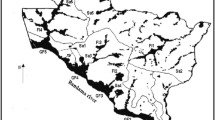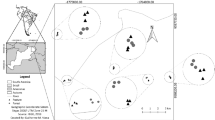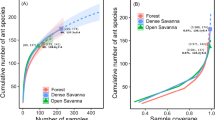Abstract
Tropical rainforests are characterized by having high structural complexity, stratification, and species diversity. In Colombia, tropical rainforests are critically endangered with only 24% of their area remaining. Forest fragments are often valued based on the presence of vertebrate taxa despite that small habitat remnants may still harbor diverse invertebrate communities. We surveyed the ant fauna associated with rainforest fragments and their surrounding landscape elements (including mature forests, flooded forests, gallery forests, live fences, and pastures) in the Magdalena River watershed. Pitfall traps and litter samples were used to estimate ant richness and diversity, and to compare ant composition among landscape elements. We found 135 species from 42 genera, representing 16% of the species and 43% of the genera known for Colombia. Our surveys also uncovered 11 new ant records for the Colombian inter-Andean region and 2 new records for the country of Colombia: Mycocepurus curvispinosus (Mackay) and Rhopalothrix isthmica (Weber). The highest species richness was found in forest-covered sites, and richness and diversity was lower in the disturbed landscapes surrounding the forest patches. Species composition varied significantly between all habitat types, but was most similar between forest types suggesting that a loss of structural complexity has the greatest effect on ant communities. Across our study sites, ten species showed the greatest response to habitat type and could qualify as indicator taxa for this region. We conclude by discussing the value of conserving even small forests in this landscape due to their ability to retain high diversity of ants.





Similar content being viewed by others
References
Achury R, Chacón de Ulloa P, Arcila A (2012) Effects of the heterogeneity of the landscape and the abundance of Wasmannia auropunctata on ground ant assemblages in a Colombian tropical dry forest. Psyche 2012:1–12. https://doi.org/10.1155/2012/960475
Agosti D, Majer JD, Alonso LE, Schultz TR (2000) Ants: standard methods for measuring and monitoring biodiversity. Smithsonian Institution Press, Washington DC, p 280
Alonso LE (2000) Ants as indicators of diversity. In: Agosti D, Majer JD, Alonso LE, Schultz TR (eds) Ants: standard methods for measuring and monitoring biodiversity. Smithsonian Institution Press, Washington DC, pp 80–88
Andersen AN (1997) Using ants as bioindicators: multiscale issues in ant community ecology. Conserv Ecol 1:1–8
Andersen AN, Majer JD (2004) Ants show the way down under: invertebrates as bioindicators in land management. Front Ecol Environ 2(6):291–298. https://doi.org/10.1890/1540-9295(2004)002[0292:ASTWDU]2.0.CO;2
Andersen AN, Hoffman BD, Muller WJ, Griffiths AD (2002) Using ants as bioindicators in land management: simplifying assessment of ant community responses. J Appl Ecol 39(1):8–17. https://doi.org/10.1046/j.1365-2664.2002.00704.x
AntWeb (2015) AntWeb. https://wwwantweborg. Accessed 11 Nov 2015
Armbrecht I, Perfecto I (2003) Litter-twig dwelling ant species richness and predation potential within a forest fragment and neighboring coffee plantations of contrasting habitat quality in Mexico. Agric Ecosyst Environ 97(1-3):107–115. https://doi.org/10.1016/S0167-8809(03)00128-2
Bestelmeyer BT, Wiens JA (1996) The effects of land use on the structure of ground-foraging ant communities in the Argentine Chaco. Ecol Appl 6(4):1225–1240. https://doi.org/10.2307/2269603
Bluthgen N, Gebauer G, Fiedler K (2003) Disentangling a rainforest food web using stable isotopes: dietary diversity in a species-rich ant community. Oecologia 137(3):426–435. https://doi.org/10.1007/s00442-003-1347-8
Carvalho KS, Vasconcelos LH (1999) Forest fragmentation in central Amazonia and its effects on litter-dwelling ants. Biol Conserv 91(2-3):151–157. https://doi.org/10.1016/S0006-3207(99)00079-8
Castaño-Uribe C (2003) Río Grande de la Magdalena. Banco de Occidente, Bogotá, p 208
Colwell RK (2013) EstimateS: statistical estimation of species richness and shared species from samples. Version 9.1.0. http://purl.oclc.org/estimates. Accessed 26 Sept 2015
Cook WM, Lane KT, Foster BL, Holt RD (2002) Island theory, matrix effects and species richness patterns in habitat fragments. Ecol Lett 5(5):619–623. https://doi.org/10.1046/j.1461-0248.2002.00366.x
Corlett R, Primack RB (2010) Tropical rainforests: an ecological and biogeographical comparison. Wiley-Blackwell Publishing, Malden, p 336
Cuartas AC, Muñoz A (2003) Lista de los Mamíferos (Mammalia: Theria) del departamento de Antioquia, Colombia. Biota Colomb 4:65–78
Dauber J, Bengtsson J, Lenoir L (2006) Evaluating effects of habitat loss and land-use continuity on ant species richness in seminatural grassland remnants. Conserv Biol 20(4):1150–1160. https://doi.org/10.1111/j.1523-1739.2006.00373.x
Dufrêne M, Legendre P (1997) Species assemblages and indicator species: the need for a flexible asymmetrical approach. Ecol Monogr 67:345–366
Etter A (1998) Bosque húmedo. In: Chávez M, Arango N (eds) Informe Nacional sobre el Estado de la Biodiversidad. Colombia. Instituto de Investigación de Recursos Biológicos Alexander von Humboldt, Bogotá, pp 106–133
Etter A, Mcalpine C, Wilson K, Phinn S, Possingham H (2006) Regional patterns of agricultural land use and deforestation in Colombia. Agric Ecosyst Environ 114(2-4):369–386. https://doi.org/10.1016/j.agee.2005.11.013
Fandiño-Lozano M, van Wyngaarden W (2005) Prioridades de Conservación Biológica para Colombia. Grupo ARCO, Bogotá, p 188
Fernández F (2006) Caracterización de la diversidad de hormigas en Colombia. In: Chávez ME, Santamaría M (eds) Informe sobre el avance en el conocimiento y la información de la biodiversidad 1998–2004. Instituto de Investigación de Recursos Biológicos Alexander von Humboldt, Bogotá, pp 288–290
Foley JA, Defries R, Asner GP, Barford C, Bonan G, Carpenter SR, Chapin FS, Coe MT, Daily GC, Gibbs HK, Helkowski JH, Holloway T, Howard EA, Kucharik CJ, Monfreda C, Patz JA, Prentice IC, Ramankutty N, Snyde PK (2005) Global consequences of land use. Science 309(5734):570–574. https://doi.org/10.1126/science.1111772
Folgarait PJ (1998) Ant biodiversity and its relationship to ecosystem functioning: a review. Biodivers Conserv 7(9):1221–1244. https://doi.org/10.1023/A:1008891901953
Frouz J, Jilkova V (2008) The effect of ants on soil properties and processes (Hymenoptera: Fomicidae). Myrmecol News 11:191–199
Gerlach J, Samways M, Pryke J (2013) Terrestrial invertebrates as bioindicators: an overview of available taxonomic groups. J Insect Conserv 17(4):831–850. https://doi.org/10.1007/s10841-013-9565-9
Google Inc (2017) Google Earth V9.1.39.1 https://earth.google.com/web/@6.70871005,-74.35549682,119.44407498a,13522.49084828d,35y,-0h,0t,0r. Accessed 7 Aug 2017
Gotelli NJ, Colwell RK (2001) Quantifying biodiversity: procedures and pitfalls in the measurement and comparison of species richness. Ecol Lett 4(4):379–391. https://doi.org/10.1046/j.1461-0248.2001.00230.x
Gotelli NJ, Ellison AM (2004) A primer of ecological statistics. Sinauer Associates, Inc, Sunderland, p 492
Gotzek D, Axen HJ, Suarez AV, Helms Cahan S, Shoemaker D (2015) Global invasion history of the tropical fire ant: a stowaway on the first global trade routes. Mol Ecol 24(2):374–388. https://doi.org/10.1111/mec.13040
Haddad NM, Brudvig LA, Clobert J, Davies KF, Gonzalez A, Holt RD, Lovejoy TE, Sexton JO, Austin MP, Collins CD, Cook WM, Damschen EI, Ewers RM, Foster BL, Jenkins CN, King AJ, Laurance WF, Levey DJ, Margules CR, Melbourne BA, Nicholls AO, Orrock JL, Song DX, Townshend JR, (2005) Habitat fragmentation and its lasting impact on Earth’s ecosystems. Science Adv 1. https://doi.org/10.1126/sciadv.1500052
Hernández-Camacho JI, Hurtado A, Ortiz R, Walschburger T (1992) Centros de endemismo en Colombia. In: Halfter G (ed) La diversidad biológica de Iberoamérica I. Acta Zoológica Mexicana, México, pp 175–190
Herrera-Rangel J, Jiménez-Carmona E, Armbrecht I (2015) Monitoring the diversity of hunting ants (Hymenoptera: Formicidae) on a fragmented and restored Andean landscape. Environ Entomol 44(5):1287–1298. https://doi.org/10.1093/ee/nvv103
Hölldobler B, Wilson EO (1990) The ants. Harvard University Press, Cambridge, p 732. https://doi.org/10.1007/978-3-662-10306-7
Jost L (2006) Entropy and diversity. Oikos 113(2):363–374. https://doi.org/10.1111/j.2006.0030-1299.14714.x
Kremen C, Cameron A, Moilanen A, Phillips SJ, Thomas CD, Beentje H, Dransfield J, Fisher BL, Glaw F, Good TC, Harper GJ, Hijmans RJ, Lees DC, Louis E, Nussbaum RA, Raxworthy CJ, Razafimpahanana A, Schatz GE, Vences M, Vietes DR, Wright PC, Zjhra ML (2005) Aligning conservation priorities across taxa in Madagascar with high-resolution planning tools. Science 320:222–226
Lach L, Parr CL, Abott KL (2010) Ant ecology. Oxford University Press, New York, p 402
Lawton JH, Bignell DE, Bolton B, Bloemers GF, Eggleton P, Hammond PM, Hodda M, Holt RD, Larsen TB, Mawdsley NA, Stork NE, Srivastava DS, Watt AD (1998) Biodiversity inventories, indicator taxa and effects of habitat modification in tropical forest. Nature 391(6662):72–76. https://doi.org/10.1038/34166
Longcore T (2003) Terrestrial arthropods as indicators of ecological restoration success in coastal sage scrub (California, USA). Restor Ecol 11(4):397–409. https://doi.org/10.1046/j.1526-100X.2003.rec0221.x
Longino JT (2009) Ants of Costa Rica. http://academicevergreenedu/projects/ants/AntsofCostaRicahtml. Accessed 07 Feb 2013
Longino JT, Boudinot BE (2013) New species of central American Rhopalothrix Mayr 1870 (Hymenoptera, Formicidae). Zootaxa 3616:301–324. 10.11646/zootaxa.3616.4.1
Lozano-Zambrano FH, Mendoza JE, Vargas AM, Renjifo LM, Jiménez E, Caycedo PC, Vargas W, Aristizábal SL, Ramírez DP (2009) Oportunidades de conservación en el paisaje rural (Fase I). In: Lozano-Zambrano FH (ed) Herramientas de manejo para la conservación de biodiversidad en paisajes rurales. Instituto de Investigación de Recursos Biológicos Alexander von Humboldt, Bogotá, pp 41–83
Mackay WP, Maes JM, Rojas P, Luna G (2004) The ants of north and central America: the genus Mycocepurus (Hymenoptera : Formicidae). J Insect Sci 4(27):1–7. https://doi.org/10.1673/031.004.2701
Majer JD, Delabie JHC, McKenzie NL (1997) Ant litter fauna of forest, forest edges and adjacent grassland in the Atlantic rain forest region of Bahia, Brazil. Insect Soc 44(3):255–266. https://doi.org/10.1007/s000400050046
McCune B, Grace JB (2002) Analysis of ecological communities. MjM Software Design, Gleneden Beach, p 300
McCune B, Mefford MJ (1999) PC-ORD. Multivariate analysis of ecological data. MjM Software Design, Gleneden Beach Version 4
McGeogh MA (1998) The selection, testing and application of terrestrial insects as bioindicators. Biol Rev 73(2):181–201. https://doi.org/10.1017/S000632319700515X
OPEPA Organización para la Educación y Protección Ambiental (2013) Bosque Húmedo Tropical - Descripción Completa. http://wwwopepaorg/indexphp?Itemid=31&id=202&option=com_content&task=view. Accessed 12 Jul 2015
Palacio EE, Fernández F (2003) Clave para las subfamilias y géneros. In: Fernández F (ed) Introducción a las hormigas de la región neotropical. Instituto de Investigación de recursos Biológicos Alexander von Humboldt, Bogotá, pp 233–260
Perfecto I, Armbrecht I, Philpott SM, Soto-Pinto L, Dietsch TV (2007) Shaded coffee and the stability of rainforest margins in Latin America. In: Tscharntke T, Leuschner C, Zelle M, Guhadja E, Bidin A (eds) The stability of tropical rainforest margins: linking ecological, economic and social constraints of land use and conservation. Springer Verlag, Berlin, pp 227–263. https://doi.org/10.1007/978-3-540-30290-2_12
Philpott SM, Perfecto I, Armbrecht I, Parr CL (2010) Ant diversity and function in disturbed and changing habitats. In: Lach L, Parr CL, Abbott KL (eds) Ant ecology. Oxford University Press, New York, pp 137–156
Ribas CR, Campos RBF, Schmidt FA, Solar RRC (2012) Ants as indicators in Brazil: a review with suggestions to improve the use of ants in environmental monitoring programs. Psyche 2012:1–23. https://doi.org/10.1155/2012/636749
Sanders NJ, Moss J, Wagner D (2003) Patterns of ant species richness along elevational gradients in an arid ecosystem. Glob Ecol Biogeogr 12(2):93–102. https://doi.org/10.1046/j.1466-822X.2003.00324.x
Silva RR, Feitosa RSM, Eberhardt F (2007) Reduced ant diversity along a habitat regeneration gradient in the southern Brazilian Atlantic Forest. Forest Ecol Manag 240(1-3):61–69. https://doi.org/10.1016/j.foreco.2006.12.002
Solar RRDC, De Barlow J, Ferreira J, Berenguer E, Lees AC, Thomson JR, Louzada J, Maués M, Moura NG, Oliveira VHF, Chaul JCM, Schoereder JH, Vieira ICG, MacNally R, Gardner TA (2015) How pervasive is biotic homogenization in human-modified tropical forest landscapes? Ecol Lett 18(10):1108–1118. https://doi.org/10.1111/ele.12494
Stattersfield AJ, Crosby MJ, Long AJ, Wege DC (1998) Endemic bird areas of the world: priorities for biodiversity conservation. BirdLife International, Cambridge, p 864
Stein A, Gerstner K, Kreft H (2014) Environmental heterogeneity as a universal driver of species richness across taxa, biomes and spatial scales. Ecol Lett 17(7):866–880. https://doi.org/10.1111/ele.12277
Suarez AV, Bolger DT, Case TJ (1998) Effects of fragmentation and invasion on native ant communities in coastal southern California. Ecology 79(6):2041–2056. https://doi.org/10.1890/0012-9658(1998)079[2041:EOFAIO]2.0.CO;2
Tschinkel WR, Murdock T, King JR, Kwapich C (2012) Ant distribution in relation to ground water in north Florida pine flatwoods. J Insect Sci 12(114):1–20. https://doi.org/10.1673/031.012.11401
Uehara-Prado M, Fernandes JO, Bello AM, Machado G, Santos AG, Vaz-De-Mello FZ, Freitas AVL (2009) Selecting terrestrial arthropods as indicators of small-scale disturbance: a first approach in the Brazilian Atlantic Forest. Biol Conserv 142(6):1220–1228. https://doi.org/10.1016/j.biocon.2009.01.008
Vasconcelos HL (1999) Effects of forest disturbance on the structure of ground-foraging ant communities in central Amazonia. Biodivers Conserv 8:409–420
Vergara-Navarro EV, Serna F (2013) A checklist of the ants (Hymenoptera: Formicidae) of the department of Antioquia, Colombia and new records for the country. Agron Colomb 31:324–342
Villarreal H, Álvarez M, Córdoba S, Escobar F, Fagua G, Gast F, Mendoza H, Ospina M, Umaña AM (2004) Manual de métodos para el desarrollo de inventarios de biodiversidad. Instituto de Investigación de Recursos Biológicos Alexander von Humboldt, Bogotá, p 236
Wetterer JK (2010) Worldwide spread of the pharaoh ant, Monomorium pharaonis. Myrmecol News 13:115–129
Wetterer JK (2011) Worldwide spread of the tropical fire ant, Solenopsis geminata. Myrmecol News 14:21–35
Wetterer JK (2015) Geographic origin and spread of cosmopolitan ants (Hymenoptera: Formicidae). Halteres 6:66–78
WWF (2001) Northern South America: northern Colombia. http://wwwworldwildlifeorg/ecoregions/nt0137. Accessed 6 Apr 2015
Yanoviak SP, Kaspari ME (2000) Community structure and the habitat templet: ant assemblages in the tropical canopy and litter. Oikos 89(2):259–266. https://doi.org/10.1034/j.1600-0706.2000.890206.x
Yeo K, Delsinne T, Konate S, Alonso LL, Aidara D, Peeters C (2016) Diversity and distribution of ant assemblages above and below ground in West African forest-savannah mosaic (Lamto, Cote d’Ivoire). Insec Soc 64:155–168
Acknowledgements
The authors would like to express their sincere thanks to Jack Longino for the corroboration of the new record of Rhopalothrix isthmica, and Juan Carlos Abadía for his invaluable help in data collection. We also thank Fundación Biodiversa and especially Fernando Arbeláez for giving us the logistical and financial support for this research. We appreciate the kindness of the landowners and forest administrators for permission to conduct this research. Finally, we thank the Suarez Lab members and three anonymous reviewers who made valuable comments on the manuscript.
Author information
Authors and Affiliations
Corresponding author
Additional information
Edited by Edison R. Sujii
Rights and permissions
About this article
Cite this article
Achury, R., Suarez, A.V. Richness and Composition of Ground-dwelling Ants in Tropical Rainforest and Surrounding Landscapes in the Colombian Inter-Andean Valley. Neotrop Entomol 47, 731–741 (2018). https://doi.org/10.1007/s13744-017-0565-4
Received:
Accepted:
Published:
Issue Date:
DOI: https://doi.org/10.1007/s13744-017-0565-4




